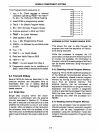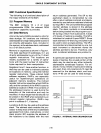
SINGLE COMPONENT SYSTEM
8022
Functional Specifications
The
8022's
architecture is based
upon
the 8021,
and
many functions of the two parts are identical.
2.12 Program Memory
The
8022
program memory consists of
2048
words 8 bits wide which are addressed by the
program counter.
The
memory is
ROM
which is
mask
programmable at the factory.
No
external
ROM
expansion capability is provided. There are
three
locations
in
program memory of special
im-
portance.
Location
0: Activating the
RESET
line
of the pro-
cessor causes the first instruction to
be fetched from
location
O.
Location 3: Activating the interrupt input line
(TO)
of the processor (if interrupt is
enabled) causes a jump to subrou-
tine.
Location
7:
A timer / event counter interrupt
re-
sulting from a timer / counter over-
flow
causes a jump to subroutine (if
timer / counter interrupt is
enabled).
Therefore, the first instruction to be executed
after
initialization is stored
in
location 0, the first
word of
an
external interrupt service routine is
stored
in
location 3,
and
the first word of a timer-
/ event counter interrupt service routine is stored
in
location
7.
204 7
8
7
6
5
76543210
LOCATION
7 - TIMER/COUNTER INTERRUPT
VECTORS
PROGRAM
HERE
LOCATION
3-EXTERNAL
INTERRUPT
VECTORS PROGRAM HERE
RESEr
VECTORS PROGRAM HERE
PROGRAM MEMORY MAP
Program memory can
be
used
to store constants
as
well as program instructions.
The
MOVP
in-
struction allows easy table lookup for constants
and
display formatting.
2-25
2.13 Data Memory
On-chip data memory is organized as 64 words
eight bits wide.
All
locations are indirectly addres-
sable
and
eight designated locations are directly
addressable. Also included
in
the data memory is
the program counter stack, addressed by a 3-bit
stack pointer.
The
first eight locations
(0-7)
of the array are
designated as working registers
and
are directly
addressable
by any of the
11
direct register
instructions. These
locations are readily accessi-
ble
for a variety of operations with a
minimum
num-
ber
of
instruction
bytes
required
for
their
manipulation.
Thus,
they are usually used to store
frequently accessed intermediate results.
The
DJNZ instruction makes very efficient use of the
working registers as program
loop counters by
al-
lowing the programmer to decrement
and
test the
register
in
a single instruction.
Registers
a
and
1 have yet another function
in
that
they
can
be
used
to indirectly address all loca-
tions
in
the data memory
using
the indirect register
instructions. These two
RAM
pointer registers are
especially
useful for repetitive type operations
on
adjacent memory locations.
The
indirect register
instruction specifies which register is used to
ad-
dress a location
in
RAM.
The
contents of the ad-
dressed location are used during the execution of
the instruction
and
may be modified.
The
pointer
registers may
also point to registers
0-7,
if de-
sired.
Locations
8-23
serve a
dual
role
in
that they
con-
tain the 8-level program counter stack, two
RAM
locations per level.
The
program counter stack
en-
ables the processor to keep track of the return
addresses generated by
interrupts
or
CALL
instructions by storing the contents of the program
counter prior to servicing the subroutine. A 3-bit
stack pointer determines which of the program
counter stack's eight register pairs will be
loaded
with the next return address generated.
The
stack
pointer,
when
initialized to 000 by
RESET,
points
to
RAM
locations 8
and
9.
The
first subroutine
CALL or interrupt
results
in
the program counter
contents
being
transferred to locations 8
and
9.
The
stack pointer is then incremented by
one
and
pOints
to locations 10
and
11
in
anticipation of
an-
other
CALL
The
end
of a subroutine, which is sig-
naled
by a return instruction (RET
or
RETI),
causes the stack pointer to be decremented
and
the contents of the resulting register pair to be
transferred to the program counter.


















